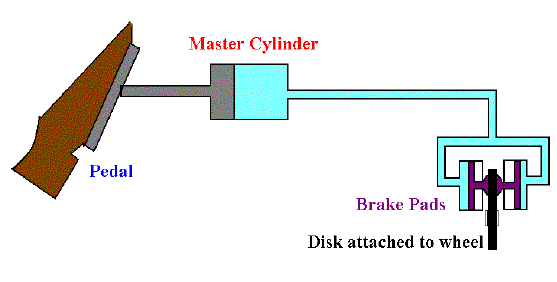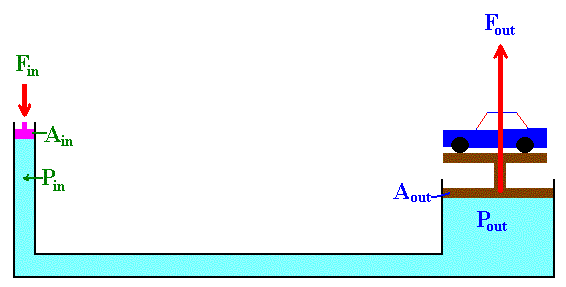|
Pascal's Principle
Introduction
| Pascal's Principle |
A pressure applied to a confined fluid
increases the pressure throughout by the same amount. |
The Earth's atmosphere exerts a pressure on all objects with
which it is in contact, including other fluids.
The pressure due to water pressure 100. m below the surface
of a lake is
P =  gh = 1.00 x
10 3 kg/m 3 x 9.80 m s -2 x 100. m
= 9.80 x 10 5 Pa = 9.7 atm gh = 1.00 x
10 3 kg/m 3 x 9.80 m s -2 x 100. m
= 9.80 x 10 5 Pa = 9.7 atm
P Total = P water
+ P air = 9.7 atm + 1.0 atm =
10.7 atm
 The
brake system to the left is a practical application of Pascal's Principle.
F = PA The
brake system to the left is a practical application of Pascal's Principle.
F = PA
Since the pressure is the same at the Master Cylinder and the
Brake Pads, a force applied to the Master Cylinder gives a larger force at
the Brake Pads. An important point, the distance traveled by the pedal is
greater than the distance traveled by the Brake Pads.
 The
hydraulic lift is another practical application of Pascal's Principle. The
hydraulic lift is another practical application of Pascal's Principle.
P out = P in
F out F in
-------- = -------
A out A in
F out
A out
-------- = ----------
F in
A in
F out / F in is the Mechanical
Advantage of the system. If the area out is 20 times greater than the area
in, a 200. lbs force can lift a 4000. lbs car.
Table of Contents
Problems
| 1. |
The maximum gauge pressure in a hydraulic
lift is 18 atm. What is the largest mass vehicle it can lift if the
diameter of the output line is 22 cm?
|
| 2. |
 Pascal
placed a long tube with a radius of 0.300 cm into a barrel with a 20.0 cm
radius top. When the water was filled to the 12.0 m height the
barrel burst. Pascal
placed a long tube with a radius of 0.300 cm into a barrel with a 20.0 cm
radius top. When the water was filled to the 12.0 m height the
barrel burst.
(a) Calculate the mass of water in the tube.
(b) Calculate the net force on the lid.
|
| 3. |
What is the total pressure on a diver 45.0
m below the sea? Physics Charts - Densities of Substances
|
| 4. |
The master cylinder of a brake system has a
radius of 0.100 cm and the cylinders at the brake pads have radii of 4.00
cm. If Debi can apply a force of 150. N on the brake pedal,
what is the force applied to slow down her car? |
Table of Contents
Answers
| 1. |
The maximum gauge pressure in a hydraulic
lift is 18 atm. What is the largest mass vehicle it can lift if the
diameter of the output line is 22 cm?
|
|
1.013 x 10 5 N m -2
18 atm x -------------------------- = 1.82 x
10 6 N m -2
1 atm
22cm = 0.22 m =
d
A =  r2
= r2
=  x ( 0.11 m ) 2
= 0.0380 m 2 x ( 0.11 m ) 2
= 0.0380 m 2
F = P x A = 1.82
x 10 6 N m -2 x
0.0380 m 2 = 6.92 x 10 4 N
F 6.92 x 10 4
N
m = ---- = -------------------- = 7060
kg
g 9.80 m
s -2
|
|
|
| 2. |
 Pascal
placed a long tube with a radius of 0.300 cm into a barrel with a 20.0 cm
radius top. When the water was filled to the 12.0 m height the
barrel burst. Pascal
placed a long tube with a radius of 0.300 cm into a barrel with a 20.0 cm
radius top. When the water was filled to the 12.0 m height the
barrel burst.
(a) Calculate the mass of water in the tube.
(b) Calculate the net force on the lid.
|
|
(a) m = V x D =  r2
h x D = r2
h x D =  ( 0.00150 m )2
x 12.0 m x 1.00 x 10 3 kg m -3 = 8.48 x
10 -2 kg ( 0.00150 m )2
x 12.0 m x 1.00 x 10 3 kg m -3 = 8.48 x
10 -2 kg
(b)
F out
A out
F in x A out
8.48 x 10 -2 kg x 9.80 m s -2 x  x ( 0.200 m ) 2
x ( 0.200 m ) 2
-------- = ---------- => F out
= ----------------- =
----------------------------------------------------------------
F in
A in
A in
 (
0.00150 m )2 (
0.00150 m )2
F out = 1.48 x 10 4 N
|
|
|
| 3. |
What is the total pressure on a diver 45.0
m below the sea? Physics Charts - Densities of Substances
|
|
P total = P water
+ P atmosphere
P total =  gh
+ P atmosphere = 1.025 x 10 3 kg m
-3 x 9.80 m s -2 x 45.0 m + 101300 Pa gh
+ P atmosphere = 1.025 x 10 3 kg m
-3 x 9.80 m s -2 x 45.0 m + 101300 Pa
P total = 5.53 x 10
5 Pa = 553 kPa
|
|
|
| 4. |
The master cylinder of a brake system has a
radius of 0.100 cm and the cylinders at the brake pads have radii of 4.00
cm. If Debi can apply a force of 150. N on the brake pedal,
what is the force applied to slow down her car?
|
|
F out
A out
F in x A out
150. N x 4 x  x ( 4.00 cm ) 2 x ( 4.00 cm ) 2
-------- = ---------- => F out
= ----------------- =
------------------------------------------- = 9.6 x 10 5
N
F in
A in
A in
 (
0.100 cm )2 (
0.100 cm )2
|
Table of Contents
|